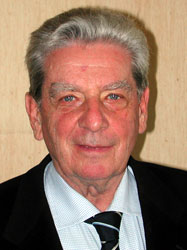 Paul Feinmann
Paul Feinmann
Born 1928 in Zurich . Maturity examination 1948 Trogen (AR)
1954 Swiss federal license in dentistry at Berne University Dental School
1954 - 1955 Assistant of prof. Herren, chairman of the Orthoidontic Department at Berne University Dental School
1955 - 1956 Studies at Northwestern University Dental School in Chicago / USA DDS degree
1956 - 1958 Instructor in Prosthetics at Northwestern University Dental School in Chicago. Fixed Prosthetics Prof. Siberhorn, removable prosthetics Prof. Grounwald. Dr. Med. Dent degree from Westdeutsche Kieferklinik Dusseldorf , Germany
1958 - 1963 Collaborator in private practice in Lugano Switzerland and Monte Carlo, Monaco
Since 1963 Own private practice in Geneva Switzerland. Main interest: Fixed and removable full mouth reconstructions, TMI problems, esthetic dentistry.
Former secretary and president of the American Dental Society of Switzerland and of the International Academy Of Gnathology, European Section.
International College of Dentists and American College of Dentists.
Honorary professor of Bucharest Romania University.
Lectures and cours presentations in different parts of the world.
In getting older we do not become more intelligent but we have more experience
Having had a chance to learn from Dr. John Anderson in 1957 in Chicago how we can work easier on a laid down patient and how important the application of Time and Motion considerations were, I became interested in different dental treatment concept that had nothing in common with what I learnt at Borne University Dental School where I got the Swiss federal diploma.
The use of Applied Kinesiology tests at the first patients appointment has helped me to avoided problems and made it easier to explain my clients what extra information I need before starting the real treatment.
The registration of centric jaw relation in the Trendelenburg Position - the knees higher than the mouth - is like the use of separation leafs a must.
To recommend to take impressions for full dentures under the biting pressure of the patient as vector forces. The imprints are not identical with the ones obtained with finger held impression trays.
The most frequent heath problems in the dental profession concern the wrist, the elbow and the shoulder. Efforts must be made to prevent or diminish them.
Stretching exercises are important to relax the dentist, his personal and the patient.
Special dental instruments like the CATS, abbreviated name from C Arpalien Tunnel Syndrom, can avoid troubles from a wrong wrist position f.c. while scaling.